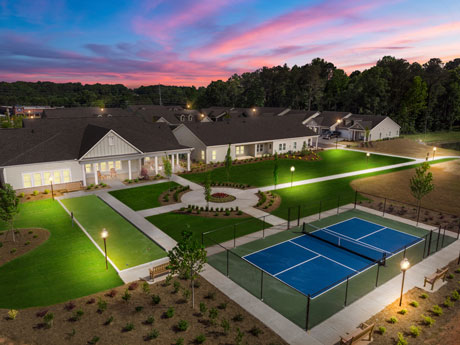Against the backdrop of rising interest rates, recent financial stress and murkiness over the Federal Reserve’s ultimate direction and economic implications, dealmaking in the first half of 2023 has remained exceedingly challenged across all real estate sectors as wide bid-ask spreads persist.
However, compared to other spaces, rental housing in the Southeast remains relatively healthy from a fundamentals perspective, despite supply-driven softening in the near term. This trend is evident in many major markets, including cities like Atlanta.

Occupancy and rent growth remain healthy in Atlanta. The rental vacancy rate for Atlanta as of January 2023 reached 5.4 percent, a 0.9 percent decrease over the previous year, based on data from the U.S. Census Bureau. This falls below the national average of 5.8 percent for the fourth quarter of 2022. The median rental rate in January 2023 was also up 4.3 percent year-over-year, reaching $1,941.
Population growth, employment opportunities, infrastructure investments, a business-friendly environment and other demand drivers continue to intensify Atlanta’s need for housing; and long term, the outlook for rental housing in the metro is very strong. More than 6 million people now live in the region, according to recent Census data. The Atlanta Regional Commission predicts more than 7.9 million people will call the metro home by 2050. And as mortgage rates surge and homeowners remain in-place, for-sale inventory has tightened, buoying single-family pricing. Thus Atlanta, long known for its relative affordability, has become more favorable to renters.
In the near term, outsized supply deliveries will start to impact specific submarkets of Atlanta and will put downward pressure on occupancies and rent growth. Beyond this 2023 and 2024 wave, however, we anticipate a muted pipeline with sidelined capital and capital market volatility creating a challenging environment for new development projects to pencil out.

Alternative forms of housing
From a rental perspective, alternative forms of housing continue to perform well in Atlanta. Build-to-rent housing and active adult communities have and will continue to be introduced to the market. By and large, Atlanta households have been receptive to new forms of housing aimed at providing solutions.
In October, Blaze acquired Hardy Springs, a 149-unit, 55-plus rental community in the Paulding County submarket of Atlanta. Our firm quickly followed this deal with the purchase of Annabelle on Main, a 180-unit, 55-plus multifamily community in Duluth, within Gwinnett County. These deals marked our firm’s first entry into Atlanta’s active adult sector as we began executing a bullish strategy for this burgeoning asset class.
The market for active adult rental housing has grown significantly over the past decade, as the baby boomer generation continues to age. As one of the largest demographics in the country, the 55-and-up crowd is hitting key life events such as retirement and becoming empty nesters who have a desire to downsize their living space and move closer to grandchildren.
In Atlanta, as well as in other Sun Belt cities, active adult communities are perfectly positioned to capture a growing cohort of active retirees looking for maintenance-free, community-centric lifestyles.
More broadly, build-to-rent single family housing offers a cost-advantage alternative for millennials who are in the midst of family formation but continue to find homeownership less attainable — providing all the benefits of single-family homes without the hidden costs, down payment requirements or upkeep.
After an exuberant two years of capital inflows and new entrants into the build-to-rent space, transaction activity has likewise cooled amidst the volatility, despite a rosy forward outlook for the sector as demand remains robust and supply headlines overstating the underlying risk.
Further, as some local municipalities throughout the Atlanta metro work to tighten parameters around build-to-rent housing, this could further impact the industry’s ability to deliver much-needed, flexible and attainably priced single-family rental housing supply.
Distinct neighborhood drivers
Despite the supply-driven choppiness that we are likely to encounter through the balance of 2023 and into 2024, Atlanta remains a magnet for rental housing within the Southeast due to the variety of opportunities available in the sprawling city. The size, scale and diversity of Atlanta is unique in that each neighborhood has such distinctive characteristics and local demand drivers.
In this way, it’s more accurate to think about Atlanta as many markets within a broader geography. The catalysts of growth in South Atlanta are very different from those on the burgeoning Westside, along the Atlanta BeltLine’s Eastside Trail or within the city’s many suburbs, creating diversified opportunity sets throughout the urban core and suburban growth corridors.
Atlanta is thriving amidst employer investments and population growth, and as more companies and people continue to migrate to this booming city, demand for housing over the long term will only grow.
— By Eddy O’Brien and Chris Riley, Co-Founders and Managing Partners of Blaze Capital Partners. This article was originally published in the June 2023 issue of Southeast Real Estate Business.


